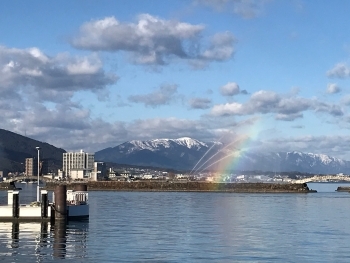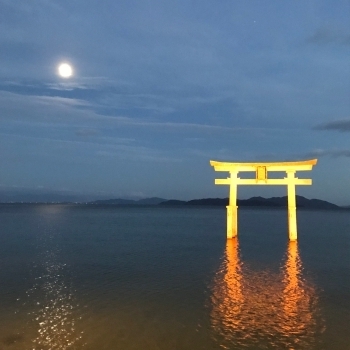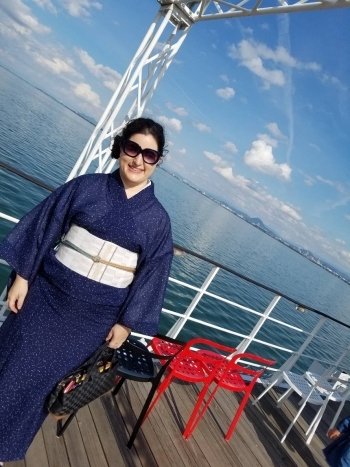Public Diplomacy
Living with the Greatest Lake in Japan
Émilie Lamont-Cardinal
Coordinator for International Relations
International Affairs Division,
Department of General Policy Planning, Shiga Prefecture
 Photo 1: A view of Lake Biwa from Otsu, with the Otsu Port fountains and Hira Mountains
Photo 1: A view of Lake Biwa from Otsu, with the Otsu Port fountains and Hira Mountains
 Photo 2: The torii for Shirahige Shrine, in Lake Biwa
Photo 2: The torii for Shirahige Shrine, in Lake Biwa
“The only thing there is Lake Biwa.”
When people talk about Shiga, that’s often what they say. As if it’s a bad thing. While it’s also not true, Lake Biwa brings so much to the prefecture and other parts of the Kansai region that having it here can only be seen as an advantage.
I arrived in Shiga in summer 2017, as a participant in the JET Programme. When I learned where I would be placed, I first mistook it for Saga, but soon discovered I was wrong. “Oh, it’s the one with Lake Biwa!” This is my 6th year as the prefectural coordinator for international relations (CIR). I’ve had plenty of time to get to know the greatest lake in Japan, and the prefecture it’s in, more personally.
The work of a CIR changes greatly from one workplace to another. In my case, working at the Shiga Prefectural Government, I have four main duties: translation and interpretation, cultural exchanges (mainly through school visits), tourism (mainly through a blog), and JET Programme prefectural advisor.
My work in translation and tourism allowed me to learn a lot about the place I currently call home, and how important Lake Biwa really is. I learned about how it provides water for the daily lives and industries of not just Shiga, but Kyoto and Osaka as well.
I learned how it shaped the culture that flourished on its shores with that water. It could be used to feed crops or other plants that then turned to food for silkworms or delicious beef. It provides a home for birds, plants and fish, many of which are endemic, which in turn can be used as food or for work. The sediments at the bottom could be turned into pottery and ceramics. Boats could be used for transport, or simply for fun. And the one river that flows out of the Lake provided a strategic military point to stop attacks on Kyoto when it was a capital.
Today, still, the people of Shiga use Lake Biwa in many aspects of their lives. Since I’ve arrived, I’ve seen many projects to protect its heritage, or allow visitors and residents alike to enjoy it.
For example, did you know that you can bike all around the Lake? The trip is called Biwaichi, and it’s part of Japan’s cycling routes. Some avid cyclists can do it within a day, but I recommend stopping along the way. Cycling along the mountains and the Lake in Nagahama and Takashima was truly a beautiful sight, and it’s a great way to see Shirahige Shrine, with its famous torii in the water.
I also learned a great deal about the different ways fishing and agriculture were affected by the people’s will to live a more ecologically-friendly life. In 2022, we were even recognized as having a globally important agricultural system! Farmers let fish into their rice paddies to reproduce, and fishermen use nets that allow smaller fish to get away and grow old.
Shiga doesn’t only look within, but aims to use its experience to help other places with lakes as well, participating in many water-related forum, and creating bonds with others all around the world.
Of course, not everything about Lake Biwa is so serious. Shiga’s JET participants have a goodbye and welcome barbecue at one of the beaches here every summer. We also used to invite JETs from all around Japan to ride the Michigan, one of the cruise boats that was named in honour of our sister state, and have a literal ball with fancy clothes and not-so-fancy dancing. Hopefully that tradition will be revived now that we’re getting into a new era of COVID. We also had an English camp on Shiga’s very own boat school. Every single 5th-grade student here gets to stay on a boat and learn about the Lake and the environment over 2 days, so we created an English version.
With my tourism work, I managed to visit all three islands on the Lake, as well as see temples and places further away that were still connected to it, through mermaids or gods. Chikubushima is what’s considered a “power spot” in Japanese, a place to go to recharge your spiritual batteries. Okishima is the only inhabited island here, home to cats and fishermen that grew from samurai families. My favourite, Takeshima, is small, but always feels like an adventure.
I’m afraid I can only give you a glimpse of all the wonders that come with the Lake. I think that people shouldn’t say that Lake Biwa is the only thing in Shiga, but that Shiga is the only place with Lake Biwa.
 Photo 3: On the Michigan Boat in kimono
Photo 3: On the Michigan Boat in kimono

